Recent Posts
How to Prevent Lingering Issues Following a Fire
4/17/2024 (Permalink)
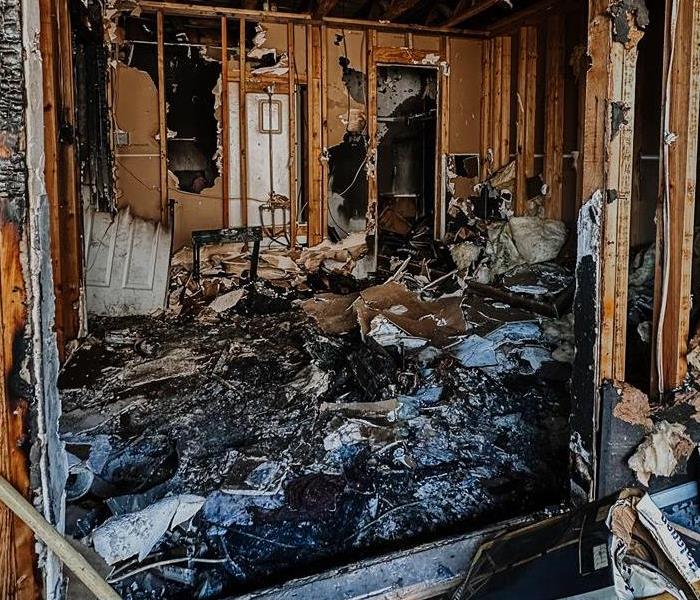 A fire caused tremendous damage to this house, leaving smoke and soot damage to the structure both inside and out.
A fire caused tremendous damage to this house, leaving smoke and soot damage to the structure both inside and out.
Not only does a fire cause visible damage to your property, it can also cause lingering problems that are hard for an untrained eye to detect such as smoke and soot damage. Smoke damage, if not taken care of immediately, can cause discoloration of surfaces, leave behind residues, and cause corrosion over time. Fires can also coat your properties in soot, which not only prolongs the cleaning process but can seep into fabrics, upholstery, and appliances as well as cause irreversible damage to flooring and walls. Lingering effects of fire damage are not limited to property damage, smoke and soot can also pose health risks affecting the respiratory system that can lead to coughing, shortness of breath, and respiratory distress.
In order to prevent further damage to your property and protect your health after you experience a fire, it is important to get a highly-trained and trusted restoration team, such as SERVPRO of Moore, to your home or business immediately. At SERVPRO of Moore, our fire restoration process provides full restoration services after a fire to your residential or commercial property to ensure it goes back to its pre-damage conditions so that you don’t experience any lingering issues such as smoke and/or soot damage. The steps to this process include:
- Step one: Contacting us. Our team is available 24/7 to answer your call to begin the restoration process. Our specialist will ask you a series of questions about the fire event that will help us arrive quickly with the right equipment and resources needed.
- Step two: Inspection and Fire Damage Assessment. This step is crucial to developing a plan of action. Our team will inspect and test adjoining rooms of your property to determine the extent of the fire, smoke and soot damage.
- Step three: Immediate Board-up and Roof-tarp Service. SERVPRO® can board up missing windows and walls and place tarp on damaged roofs to avoid further damage and maintain security.
- Step four: Water Removal and Drying. If water damage is present, we remove the water immediately, we will then use dehumidifiers and air movers to remove any remaining water and complete the drying process.
- Step five: Removal of Smoke and Soot From All Surfaces. SERVPRO uses special equipment and techniques to remove smoke and soot from walls, ceilings, and any other surfaces.
- Step six: Cleaning and Sanitizing. We will clean all of the restorable items and structures damaged by the fire by using various cleaning techniques. We are also trained to remove odors.
- Step seven: Restoration. In this final step, we will get your home to its pre-damage condition. This may involve minor repairs such as replacing drywall and installing new carpet; or major repairs such as the reconstruction of various areas in your home or business.
If your home or business experiences a fire, don’t hesitate to call SERVPRO of Moore to begin the restoration process and get your property back to normal “Like it never even happened.”
How to Prevent Mold Growth in Commercial Buildings
4/5/2024 (Permalink)
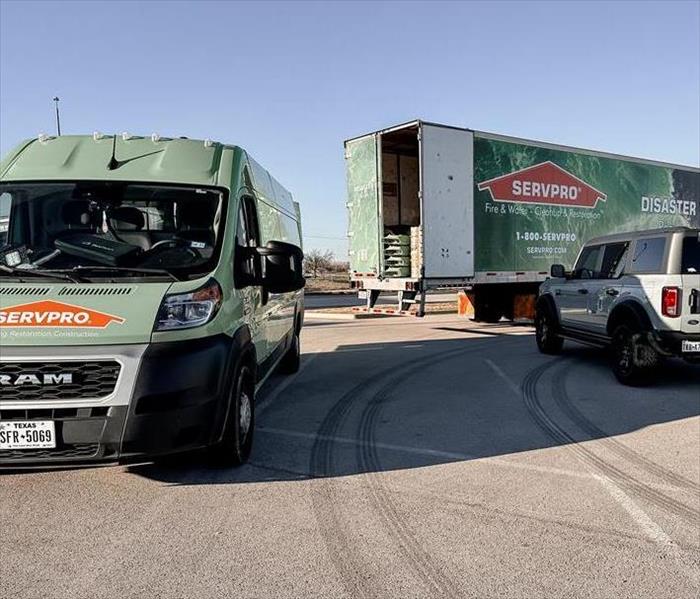 SERVPRO of Moore comes prepared with the equipment and expertise to fix your business.
SERVPRO of Moore comes prepared with the equipment and expertise to fix your business.
Understanding what mold is and how it grows
Understanding mold and how it grows is the first step in preventing your business from being affected. Mold is a fungal growth which can be found almost anywhere moisture and oxygen are present. Growth of mold can be harmful to the structure of your building and has the potential to cause health-issues if breathed in. Some common moisture problems that lead to the formation of mold growth are leaks such as from the roof or plumbing, poor drainage around the property and any scenarios of high humidity or condensation.
Knowing where to look for mold can also aid in the preventative maintenance of mold growth. Common places that mold can hide are the backside of drywall, wallpaper, the underside of carpets, paneling, and the top of ceiling tiles. Along with these areas mold can also hide in pipe chases or utility pipes if a leak is present, on walls behind furniture when condensation is present, condensate drain pans inside air handling units, and roof materials above ceiling units. Considering possible spots for mold growth is essential to ensuring your business does not suffer the consequences of this fungal infestation.
There are many suggested prevention strategies along with the knowledge of what mold is and where it grows that are available to you and your business. These strategies include:
- Fixing leaking plumbing/leaks in roofing as soon as they arise
- Prevent moisture by increasing surface temperature such as insulating or increasing air circulation
- Prevent moisture due to condensation by reducing the moisture level in the air by repairing leaks, or increasing air ventilation, or dehumidify
- Perform regular building/HVAC inspections and maintenance
- Dry/clean wet or damp spots within a 48-hour window
- Keep heating, ventilation and air conditioning (HVAC) drip pans clean and unobstructed
- Vent moisture-generating appliances such as dryers, to the outside where possible
- Don’t let foundations stay wet
- Provide drainage and slope the ground away from the foundation
If you suspect that your business might be impacted by mold, please do not hesitate to contact SERVPRO of Moore. We have the qualified experts to meet your needs and ensure your business is restored back to its normal state “Like it never even happened.”
The Top 5 Causes of Commercial Water Damage
6/1/2023 (Permalink)
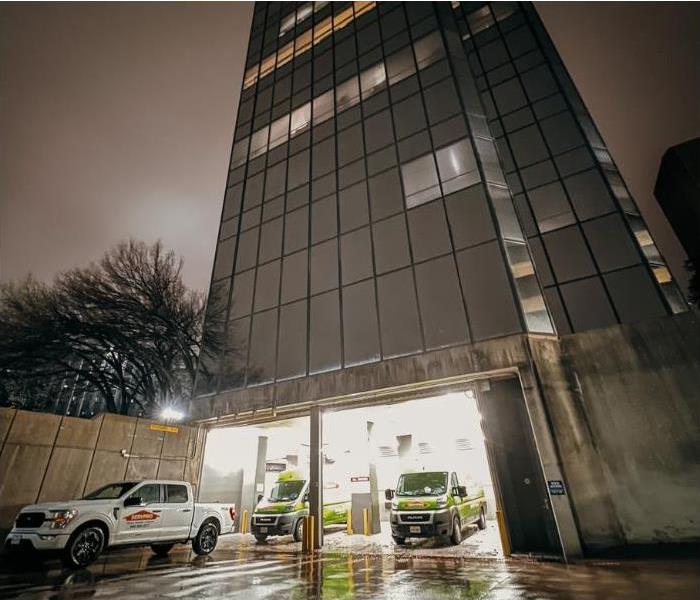 SERVPRO® of Moore is a one-stop shop for all your mitigation or restoration needs.
SERVPRO® of Moore is a one-stop shop for all your mitigation or restoration needs.
Water damage in the workplace isn’t just an inconvenience – it can be dangerous for months after the damage occurs. It’s crucial to act quickly to mitigate commercial water damage and prevent expensive secondary damages by keeping an eye on vulnerable spots in your business. There are several common causes of commercial water damage, and it’s important that you know how to spot them and what to do to fix them if there’s a problem.
Damaged or Broken Pipes Is a Top Cause Commercial Water Damage
One of the leading causes of commercial water damage is broken or damaged water pipes. Several conditions can damage pipes in your building, causing them to burst. While freezing temperatures are rare in our area, they can change the pressure in your pipes, causing them to bulge, crack, or burst. They can also be corroded over time or damaged by human error.You can spot commercial water damage caused by damaged pipes by watching out for water stains on your building’s walls, ceilings, or floors. If you see water stains, notice a mildew-like smell, or see cracked or loose tiles, you should call a professional to find and mitigate the problem. Any water-damaged materials will have to be assessed and either restored or removed.
Sprinkler System Leaks Cause Water Damage
Another cause of commercial water damage revolves around your sprinkler system. A sprinkler system can be damaged by extreme temperatures, corrosion, and mechanical damage. If your indoor sprinkler system is acting up, it can lead to leaks and water damage. Like damaged or broken pipes, you should look out for wet walls, a musty smell, or standing water inside your building. You may also notice ceiling tiles that are brown and discolored; this also indicates a problem with your sprinkler system. To avoid water damage caused by broken sprinkler systems, get a professional to inspect your sprinkler system often for potential problems.
Roof Damage is a Top Cause of Commercial Water Damage
We are no strangers to heavy wind and rain, two main causes of roof damage. When your roof is missing tiles, water may leak into the building, causing commercial water damage. This can lead to structural damage, ruin items inside your building, and mold issues. Make sure to regularly check your roof for signs of damage and provide maintenance as needed. If your roof maintains damage after a storm, it is advised to immediately contact SERVPRO of Moore for water damage restoration. Mold can grow in as little as 24 hours. Immediate inspection and water damage remediation will cost far less than water damage restoration paired with mold remediation. Not to mention the additional time it will take and the displacement of all your employees during remediation. If roof damages cause commercial water damage, contact us immediately.
Damaged HVAC System Can Cause Commercial Water Damage
It’s important to maintain your commercial HVAC system and keep it clean to keep your building free from commercial water damage. With time, HVAC systems can wear out or get damaged, leading to water leakage. To avoid this cause of commercial water damage, get a professional to clean and maintain your HVAC systems on a regular basis.
Faulty or Broken Windows Cause Water Damage
Another common cause of commercial water damage is damaged windows or window seals. Damaged windows or unsealed windows let water get into the building. If left unresolved, the excess moisture will lead to mold, damaged building materials, and more water damage. Make sure that your commercial building’s windows are sealed and in working condition. To go one step further, ensure that caulking is reapplied every few years to avoid commercial water damage.
If you suspect that your business has fallen victim to one of these causes of commercial water damage, don’t hesitate to call SERVPRO of Moore. Our professional team of water damage experts can quickly and safely fix all commercial water damage and perform mold remediation if necessary.
Tips for Avoiding Water Damage in Your Home This Summer
5/31/2023 (Permalink)
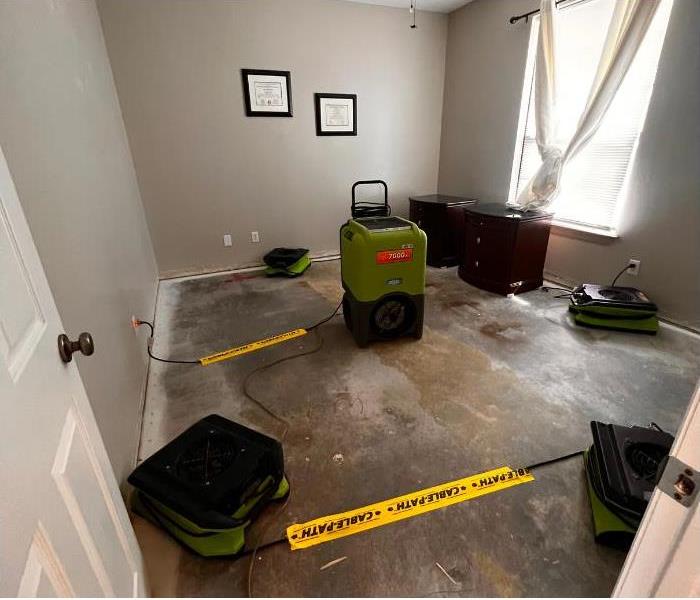 When water damage strikes your home
When water damage strikes your home
It doesn’t matter how big or small your property is, water damage is always incredibly damaging. Even if it feels warmer and drier, one thing to bear in mind during the summer season is water damage. Irrigation systems, summer storms, and a range of other factors can all pose potential hazards to your home. You can prevent more significant damage by taking measures and being aware of the main signs of damage. To learn more click the link below.
There are several signs of water damage all around the house that you should always be familiar with:
- Discoloration. Water damage can be identified by streaks of water that are running down the side of your house.
- Mold. Of course, mold can begin with a minor patch, which does not always imply water damage repair. However, you must act quickly before the problem worsens, especially because mold could also cause health problems.
- Water puddles or pools. If there is leaking or water is dripping, pools of water are frequently left.
- Smell. Moisture has a distinct odor, which is frequently combined with the musky odor of mold.
- Sound. Water damage will not always be visible, but it can certainly be heard, from dripping to rushing water.
Now that you’re aware of several of the signs of flood damage, let’s look into some of the preventative measures you can take.
- Inspect for water leakage in your house. There is really only one place to start, and that is by constantly checking for leaks. If you detect leaks faster, you can have them patched before they become larger issues.
- Clear out your gutters. You should clean your gutter systems on a frequent basis. A clogged gutter will send waves of water down the sides of your building, ruining your foundation as well as siding.
- Check to see if your yard is sloped. The yard should always slope at least 7 inches away from your property’s foundation. This is critical because it keeps water from getting close to your base, where it would cause leakages, fracture the walls, or start causing the walls to lean.
- If you are going on vacation, secure your property. If you plan to go on a summer vacation, you should seal up your property. The last thing anyone wants to discover while on a getaway is that a pipe has erupted and your living space has been ruined. Consider switching off the main supply shut-off valve and making sure all of your window panes, doors, as well as attic are tightly sealed.
Water damage requires immediate attention. If you discover any indications of flood damage, you should contact SERVPRO® of Moore quickly in order to make sure that the issue does not worsen. Our specialists will arrive with the knowledge and equipment necessary to restore your property as safely and quickly as possible.
Ten Electrical Safety Tips for Every Home
5/23/2023 (Permalink)
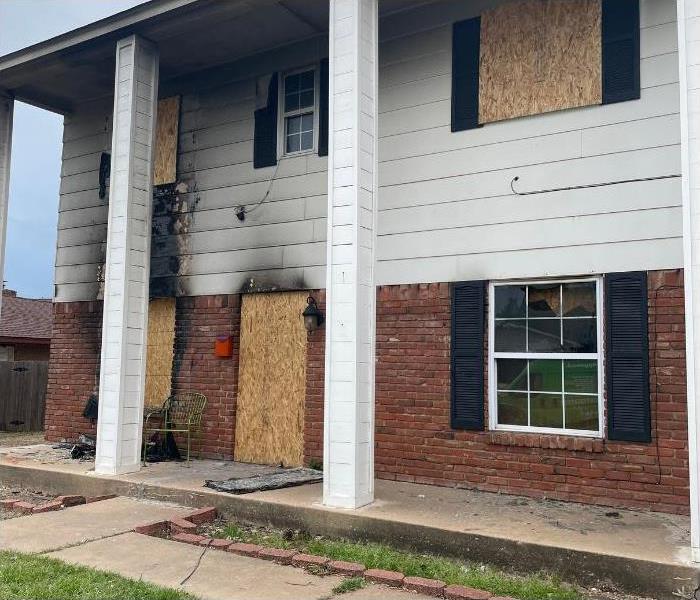 If your home has had a fire, it is important that you don't use electronics that were close to the blaze.
If your home has had a fire, it is important that you don't use electronics that were close to the blaze.
In this modern world, electricity currents are coursing all around us in our homes, helping us accomplish our daily activities. But remember that electricity still poses a possible danger to your home. Avoid accidentally causing a fire with these electrical safety tips.
Keep Your Electrical System Up-to-Date
If you’re in an older home with outdated wiring, you need to contact an electrical professional to take a look at the state of your home’s wiring. Over time, elements of your wiring may have degraded or been damaged. Older wiring also may not be able to provide the power needed to keep all of your technology and appliances running. The amount of energy is greater per each appliance today than the items they used 20 or 50 years ago. Getting it checked out and upgraded if needed will keep your home safe.
Use Appliances with Caution
Make sure you’re using appliances or items with electrical connections correctly. This means keeping appliances away from water and moisture. Another tip is to give your technology that generates internal heat space to breathe. This will allow air to circulate properly and keep the appliance or device from overheating.
Regularly Check your Electrical Cords
It’s a good safety measure to regularly check the most frequently used electrical cords in your home. Check them for frays and cracks; these can leave holes for electricity to run through and harm anything it touches. If you do discover frays and cracks, stop using that cord and get a replacement. Don’t cover cords with fabric material such as a rug or modify cords yourself. If you believe that your cords are damaged, ask a professional to take a look. To make your cords last longer, unplug them by grabbing at the base of the plug instead of yanking it out of the wall by the cord section.
Avoid Overloading Outlets
Overloading an outlet is one of the most common causes of a house fire. Don’t try to put too many plugs into one outlet. If you require more outlets than your power strip can handle, then it’s time to look into getting more outlets installed in your home.
Warm Outlets? Beware
A glaring sign of an electrical issue in your home is a warm or hot outlet. Warmth or sparking from an outlet often means that electricity is arcing inside. Using outlets like this puts your home at risk of a fire. Call an electrical professional to fix the problem.
Don’t Ignore Frequently Flickering Lights
It’s typical for lights to flicker every once in a while. But if the lights throughout your house are constantly flickering, then it’s a possible sign that your home’s wiring system can’t handle the amount of power used daily. There may be too many connections on a single circuit, or you may need to replace your electrical panel.
Block Unused Outlets
If you have small children living in your home, then we suggest you block any unused outlets for their safety. The last thing that needs to happen is an accident because a child was unknowingly playing with an outlet. Cover unused outlets with a solid plate or plug them up with safe plug covers.
Ground Older Appliances
Grounding means that electrical energy is being directed from the appliance to the earth with a resistant conductor. Check to see if your appliance is grounded properly, if not, it can pose a safety threat. If you have older or large appliances with a two-prong plug, you should replace them with a new version that has the ground prong for your safety.
Be Familiar with Your Breakers
You should be familiar with the electrical breakers in every home you live in. If you notice your breakers tripping frequently, then it may mean that you’re overloading a circuit. You need to reconfigure your appliances or update your wiring system to prevent this from continuing or turning into a bigger safety hazard.
Do You Have Fire Damage? Contact SERVPRO® of Moore
If you’ve experienced fire damage, small or big, in your home due to an electrical fire, call SERVPRO® of Moore. Our team will restore your home as quickly as possible with structural restoration, cleaning, and deodorization so you can get back to taking care of your family. Reach out to us today to assess the damage.
Understanding the Difference Between Water Extraction and Water Mitigation
5/15/2023 (Permalink)
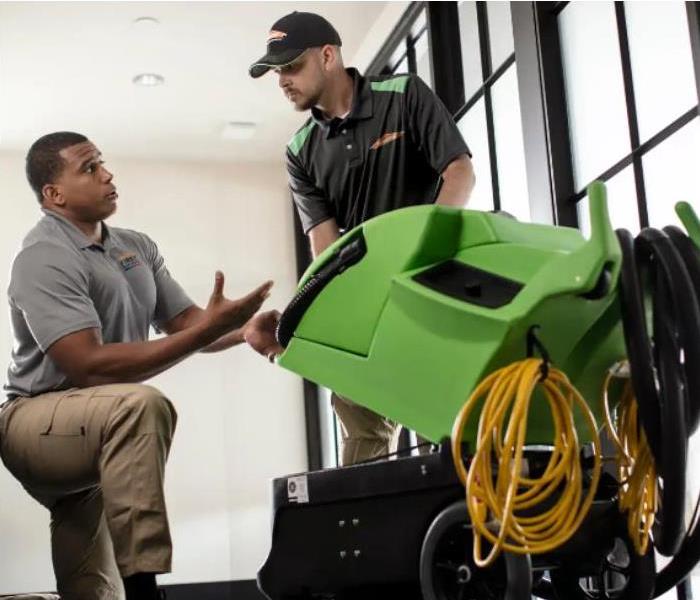 Whether it's cleaning, restoration, or construction, SERVPRO® of Moore is a one-stop shop for all your mitigation or restoration needs.
Whether it's cleaning, restoration, or construction, SERVPRO® of Moore is a one-stop shop for all your mitigation or restoration needs.
SERVPRO® of Moore water extraction services are designed for significant events like natural disasters, roof leaks, burst pipes, drainage problems, sewage backups, and whatever devastating situation could result in water damage in your home. This process ultimately removes all the visible water, speeding up the drying process and preventing the risk of further structural damage. Water mitigation, on the other hand, is more of a professional cleanup done after the water extraction process. Water mitigation cleans, sanitizes, and dries out the property. This swift action minimizes water damage by removing unsalvageable contents, disinfecting, and removing nasty smells, as well as thoroughly drying the building structure.
The difference between the two processes is the order in which they come in and the role they play in water damage restoration. Water extraction comes first, followed by the water mitigation process.
Even the smallest amount of water can be destructive, which is why it is important that water extraction be carried out first. In contrast, water mitigation stabilizes the property, keeping its integrity intact and making it fully dry for repairs to take place.
Why Are Water Extraction and Water Mitigation Necessary?
Water mitigation and extraction stop further water harm to a structure. Both entail removing water while maintaining the structural integrity of the building. If not handled properly, water infiltration can seriously harm a building’s structural elements, such as the foundation, walls, and flooring.
For this reason, both water extraction and water mitigation are important. They both support building safety and guard against health and financial risks brought on by water damage.
Contact SERVPRO® of Moore Today
After experiencing water damage, your priority should be contacting SERVPRO® of Moore for water extraction services.Our team of expert technicians works effectively to restore homes and buildings affected by water damage to pre loss conditions.
How To Restore Your Home After A Natural Disaster
5/1/2023 (Permalink)
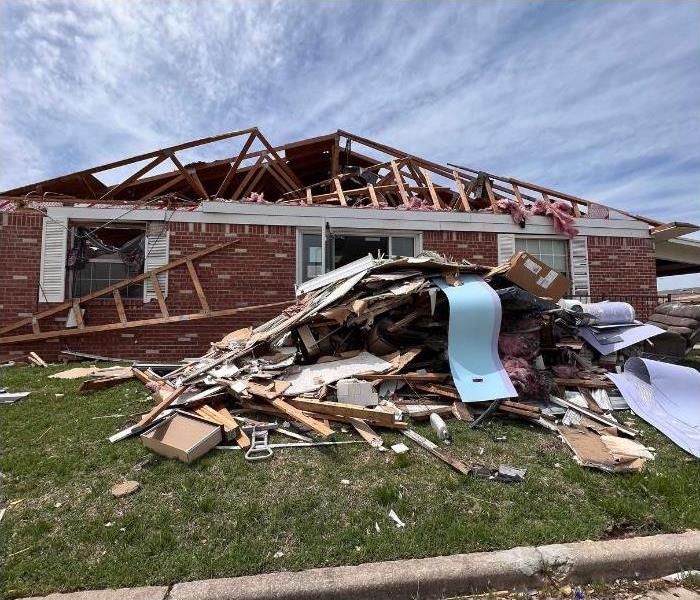 SERVPRO® of Moore is Here to Help, even on weekends. Our team of experts is on call 24/7 to respond to any emergency, no matter the size.
SERVPRO® of Moore is Here to Help, even on weekends. Our team of experts is on call 24/7 to respond to any emergency, no matter the size.
It’s been a tough year for everyone, and natural disasters have taken a toll on many homes. If your home has been affected by a severe storms, tornado, or another disaster, you may be wondering how to restore it to its former glory. Luckily, there are some SERVPRO® of Moore steps you can take to get your home back in shape. In this blog post, we’ll share some tips on how to restore your home after a natural disaster. Whether you’re dealing with water damage, wind damage, or something else, these tips will help you get your home back to normal. So if you’re ready to start the restoration process, read on!
The first step is to assess the damage. Take a look around your home and make a list of all the damaged items. Once you have a list, you can start to prioritize which repairs need to be made first. If there is structural damage, this should be your first priority. Structural damage is any damage that affects the load-bearing components of a home, such as the foundation, walls, ceilings, and/or roof. This type of damage can make a home unsafe to live in and can be very costly to repair.
In addition, if there is water damage, you will need to dry out your home and remove any mold or mildew that has formed. Water can enter your home through holes or cracks in the foundation, windows, or doors; through the roof; or from rising floodwaters. Once inside, water can damage floors, walls, furniture, and personal belongings. It can also lead to mold growth, which can pose serious health risks.
Once you have assessed the damage, it’s time to start cleaning up. First, make a plan of action. Write down what needs to be done and in what order. This will help you stay organized and avoid overlooking any important tasks. Then start with the basics. Begin by cleaning up any debris that may be inside or outside your home. This includes broken glass, downed tree limbs, etc. Finally, move on to bigger tasks next. If there is water damage, start by drying out the affected areas. Then, you can begin to repair any damage that has been done.
After you have cleaned up the debris and repaired any damage, it’s time to start thinking about prevention. Take a look at your home and identify any areas that are vulnerable to future disasters. Make sure you have strong doors and windows and consider installing storm shutters or hurricane straps. For example, storm shutters are one of the most important things you can do to protect your home from damage during a severe storm. They can be made from a variety of materials, but the most common type is metal. Taking these precautions will help you avoid future damage and make your home safer in the event of another disaster.
Restoring your home after a natural disaster can be daunting, but it is possible with the help of SERVPRO® Of Moore. We have years of experience helping homeowners recover from storms, floods, and fires. Contact us today, and we will get started on restoring your home to its original condition.
SERVPRO® Contents Management & Pack-Out Services
4/24/2023 (Permalink)
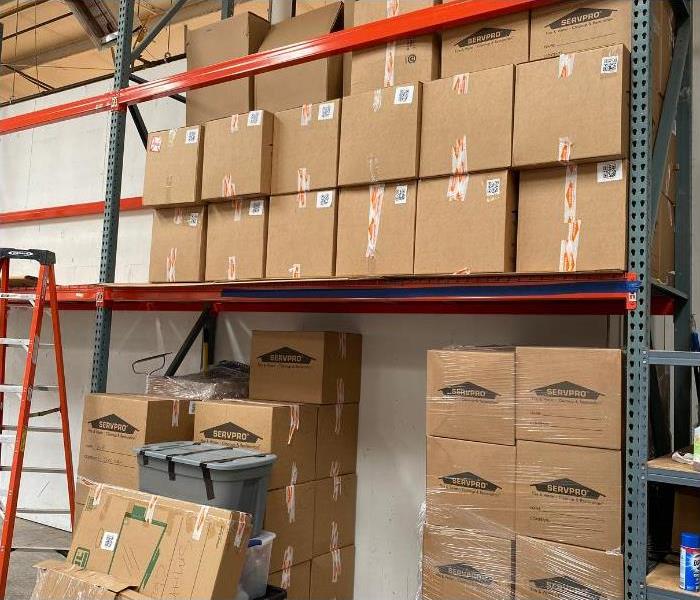 SERVPRO® Contents Management & Pack-Out Services
SERVPRO® Contents Management & Pack-Out Services
SERVPRO® Of Moore provides contents storage and pack out for your property’s items while it undergoes our restoration services! The restoration process can take some time and leave certain items open to further damage while we administer our services. After damage has occurred to your property, the restoration process can seem challenging and there are many things to consider. Our contents storage and pack out services can assist in removing valuable items, household goods, furniture, and other personal possessions out of danger and in the safety of a controlled environment. While we are able to restore your property back to a state of normalcy over time, the risk posed to valuables still exists as we do our work. SERVPRO® Of Moore is happy to extend this service to our restoration clients. While we believe these services will provide customers with a lot of relief, we understand how these services may not be familiar with them. We would like to go over our pack-out and contents management services to showcase how they can help you!
What is Contents Storage? Contents storage and pack-out services can be utilized after your property has received damage from numerous events. Whether your property has experienced damage caused by fire, water, mold, or natural disasters, our technicians can assist you in returning your property back to a state of normalcy! While we administer our restoration services, some contents may need to be packed up and placed in a safe, controlled environment. That is exactly what our contents storage service does, it allows us to ensure your items are safe from further damages. With these pack-out services, we can help protect the following items:
- Draperies, clothing, linens, and other textiles
- Leather items
- Furniture
- Electronics
- Important paper documents
- Artwork
These items can be easily damaged by events such as increased moisture at your property. Some of them may fall victim to mold colonies if an outbreak is present. Whether the item is one of the materials listed above or not, we can assist. We understand how certain heirlooms or items can hold sentimental value and we want to help preserve that memory with our contents storage. Why is Contents Storage So Important?Imagine your home or property after a flood or fire damages are sustained. The likelihood of you comfortably returning to your property in a short period of time is unlikely. These damages are extensive and can uproot your entire life and force you into a temporary location for days, weeks, or even months depending on the damage. While the restoration and remediation processes are being administered, there are times of absence. If your property is damaged with water, the damages can linger while the dry-out process occurs and could possibly affect other materials. In cases of fire damage, smoke damage can pose a threat to unaffected materials as well. Our pack-out and contents storage allow for that possibility to be removed. We place your items in our safe, controlled facility to help prevent unaffected items from being damaged. We can also place lightly damaged items in our contents storage as well to prevent further deterioration of the item.Pack-Out & Contents Storage Our pack-out services mean we will assist in the packing process of your property. These services are tailored to assist you in protecting items that escaped damage after the initial damages. First, we take a detailed inventory of the items that we will be storing in our contents storage and stored in our controlled facility. You can rest assured in knowing that your items are safely kept in a controller environment. SERVPRO® Of Moore provides restoration services for water damage, fire damage, and mold remediation. Our goal with this added service of pack-out and contents storage is to help provide you relief when you need it the most. You shouldn’t have to worry about unaffected items at your property getting damaged after the event, an unfortunate reality in certain cases.
Precautionary Measures To Prevent a Fire on Your Property
4/17/2023 (Permalink)
 Whether it's cleaning, restoration, or construction, our team is a one-stop shop for all your mitigation or restoration needs.
Whether it's cleaning, restoration, or construction, our team is a one-stop shop for all your mitigation or restoration needs.
Fires are dangerous and can pose serious risks to your health and property. Experiencing a fire can be a life-changing event for your family or business. What’s more concerning is that property fires are not uncommon. According to the National Fire Protection Association (NFPA), 1.35 million fires in 2021 caused 3,800 civilian fire deaths, 14,700 reported fire injuries and $15.9 billion worth of property damage.
The good news is SERVPRO of Moore experts can repair your property back to preloss conditions in these situations. Many causes of fires are preventable, and following fire safety tips can help keep you from falling victim to a property blaze.
Keep Matches and Lighters Out of Kids’ Reach
One of the simplest yet most effective ways to prevent a fire on your property is to keep matches, lighters, and other sources of ignition out of children’s reach. It’s also a good idea to teach kids about fire safety, conveying the message that matches and lighters are tools for adults to use, not toys for them to play with.
Install and Test Smoke Alarms Regularly
A 2021 report by the NFPA revealed that almost three out of five home fire deaths occurred in homes without smoke alarms (41 percent) or faulty detectors (16 percent). Smoke alarms and detectors give you and your loved ones enough time to escape during a fire, so it’s crucial to ensure you have them and that they’re working properly.
It’s best to install the detectors on every level of your home, inside bedrooms, and adjacent corridors. Moreover, testing your alarms every month, replacing the batteries at least once a year, and keeping the detectors clean can help toward fire prevention.
Have a Fire Extinguisher Ready
Besides checking your smoke alarms, having working fire extinguishers inside your home is also critical in the event of a fire. They aid in first-aid fire-fighting, helping you put out small fires or suppress flames until help arrives.
Considering their importance, it’s also vital that you know how to use them. Reading the directions and familiarizing yourself with how your unit operates is a good idea since you won’t have the time to do so during a fire.
Never Smoke Inside
It may seem unlikely, but cigarettes can cause destructive residential fires. The additives and materials inside them can continue to smolder even if you think you’ve put them out, and the flame can then ignite on your bed or inside your trash can and start a fire.
The most straightforward way to save yourself from having to enlist fire damage restoration is to smoke outside the home. It’s also a good idea to use deep ashtrays with water to ensure the cigarette butts are fully extinguished.
Cook With Care and Attention
A report by the NFPA also revealed that cooking activities started an average of 172,900 home structure fires every year from 2014 to 2018. The leading cause of cooking fires and the resulting casualties? Unattended cooking.
Here are some practical fire safety tips worth following to stay safe in the kitchen:
- Never leave any cooking unattended.
- Avoid wearing loose or long-sleeved clothing when cooking, as it can ignite if you get too close to the range.
- Turn all pot and skillet handles inward to keep kids from reaching into and toppling over a hot pot.
- Put combustible materials like paper products, dish towels, or oven mitts away from the stovetop.
- Clean spilled grease as soon as it cools, as built-up grease is combustible.
- Never use water to put out the flames in case of a grease fire, as the water will quickly turn into steam and cause severe burns.
- Instead, smother the flames using a fire blanket or fire extinguisher.
Practice Open Fire Safety
Fireplaces can be a cozy way to keep your home warm during winter. However, it pays to remember that they also present a fire risk, especially if used without care.
To keep your house comfortably warm and safe, it helps to have your chimney cleaned every late summer or fall before you start using it more regularly for the colder months. Once winter comes in, installing a fireplace screen helps keep the burning embers from spreading into the room and accidentally burning anyone near it.
Check Your Wirings and Appliances
If your home is an older one, it’s a good idea to have your electrical wiring system checked by a qualified electrician. Left unaddressed, issues like worn-out insulation, outdated wiring, frequently tripping breakers, and warm outlets can cause electrical malfunctions and lead to overwhelming house fires.
Besides checking your property’s wiring, it’s also crucial to use your appliances wisely. Here are some pointers to remember:
- Replace cracked or frayed electrical cords immediately.
- If an appliance begins to smoke or produce an unusual smell, unplug it right away and have it repaired.
- Avoid plugging large appliances into extension cords.
- Keep combustible materials like curtains and furniture away from space heaters.
Be Extra Careful During the Holidays
Winter holidays like Thanksgiving and Christmas are among the leading days of the year for home fires, so it’s best to remain aware of precautionary measures throughout the celebrations. Boost your fire prevention efforts by keeping these tips in mind:
- Be Careful With Your Turkey Fryers: Since they require large amounts of boiling oil and are often placed on a stand, make sure to only use them outdoors. Putting them on a stable surface and keeping kids and pets away at all times also helps prevent accidents and injuries.
- Take Care of Your Christmas Tree: Watering it every day is crucial as dried-out trees can easily catch fire.
- Inspect Your Holiday Lights Before Use: Before you light up your decorations, ensure you’re not plugging more than three sets of lights into a single extension cord. You’ll also want to check for frayed, cracked or damaged cords.
Know the Experts To Call for Help for Fire Damage Restoration
While a property fire is everyone’s worst nightmare, there are plenty of things you can do to keep your house safe and protect your loved ones from harm. Diligently following the fire safety tips listed above can make all the difference in avoiding a property blaze, minimizing losses, and preventing injuries.
Culminate your preparations by knowing the right professionals to call in case of a fire, like SERVPRO of Moore. Dealing with the aftermath of a blaze can be emotionally stressful, but our certified fire damage restoration experts are here to provide caring and immediate services to you and your property. Call us anytime for your fire and smoke damage cleanup needs.
What is Water Damage Insurance?
4/10/2023 (Permalink)
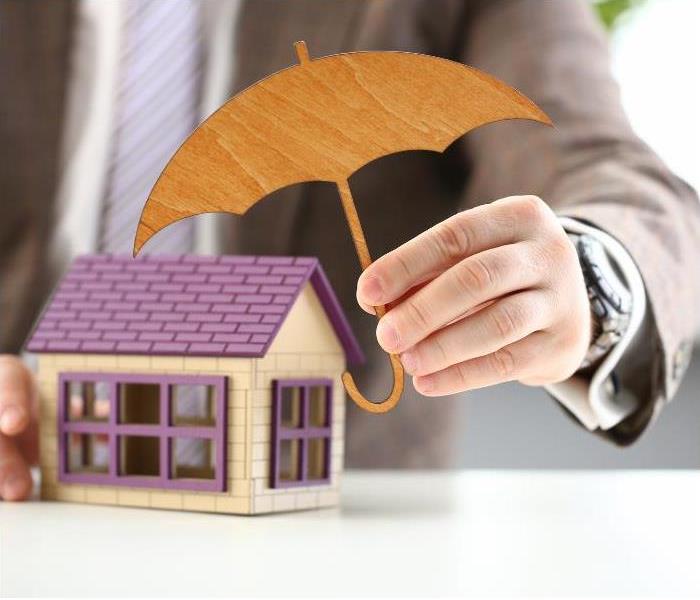 Water damage is insurance money that is paid out when your house is affected by water damage.
Water damage is insurance money that is paid out when your house is affected by water damage.
Water damage is insurance money that is paid out when your house is affected by water damage. It helps deal with the pairs. While SERVPRO of Moore comes in and helps restore your home, insurance companies ensure there are enough funds for the home restoration.
Situations Where Water Damage Insurance Works
There are situations where insurance companies will pay for the damages caused to your home. Here are the situations when your insurance will pay for your water damage:
- Accidental leaks- Insurance will take care of leaks from pipes and broken washers that cause water damage.
- Burst pipes- Water damage from burst pipes due to frozen pipes and any other incident will be covered
- Damage from fires- If the water was used to put out a fire and caused damage to your property, the damage will be insured.
- Roof leaks- If there was water damage to the interior of your house because of a roof leak, that would be catered to by insurance. The only thing you need to ensure is the leak was not caused by a fallen tree or a caved-in roof that was not fixed.
- Water damage from storms like heavy and sudden rain,
- Ice dam- Insurance will cover ice dams built in your gutter in cold months. If these ice dams result from neglect, you will not get them fixed.
Situations When Water Damage Will Not be Covered by Insurance
There are also times when your insurance will not work for water damage. Knowing about these will help you be careful with the care you give your home and figure out when you can rely on insurance and when to deal with it independently. Here are the situations where insurance will not cover water damage:
- Flood damage. Any damage caused by extreme flooding will not be covered
- Water damage is caused by negligence or lack of maintenance. If your home gets water damaged because you did not fix leaks when they occurred or did not carry out regular checks, then this will not be covered
- Damage for intentional acts. If you set your ho on fire or turn off the heat in winter, then you will not be compensated for whatever damage
- Water damage from backup sewer lines. You need to get a proper cover for that
- Cost of repairing source. No compensation will be given for a broken heater or washer.



 24/7 Emergency Service
24/7 Emergency Service







